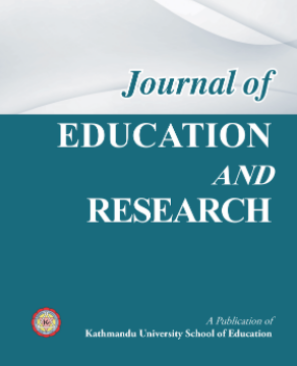
Book Review: The Politics of Language Contact in the Himalaya
Book Review
Journal of Education and Research, Volume 10, Issue 2, 2020, 119-124, https://doi.org/10.3126/jer.v10i2.32724
Publication date: Nov 11, 2020
Views: 397 | Downloads: 163
How to cite this article
APA
In-text citation: (Poudel, 2020)
Reference: Poudel, T. (2020). Book Review: The Politics of Language Contact in the Himalaya. Journal of Education and Research, 10(2), 119-124. https://doi.org/10.3126/jer.v10i2.32724
Reference: Poudel, T. (2020). Book Review: The Politics of Language Contact in the Himalaya. Journal of Education and Research, 10(2), 119-124. https://doi.org/10.3126/jer.v10i2.32724
Vancouver
In-text citation: (1), (2), (3), etc.
Reference: Poudel T. Book Review: The Politics of Language Contact in the Himalaya. Journal of Education and Research. 2020;10(2):119-24. https://doi.org/10.3126/jer.v10i2.32724
Reference: Poudel T. Book Review: The Politics of Language Contact in the Himalaya. Journal of Education and Research. 2020;10(2):119-24. https://doi.org/10.3126/jer.v10i2.32724
AMA
In-text citation: (1), (2), (3), etc.
Reference: Poudel T. Book Review: The Politics of Language Contact in the Himalaya. Journal of Education and Research. 2020;10(2), 119-124. https://doi.org/10.3126/jer.v10i2.32724
Reference: Poudel T. Book Review: The Politics of Language Contact in the Himalaya. Journal of Education and Research. 2020;10(2), 119-124. https://doi.org/10.3126/jer.v10i2.32724
Chicago
In-text citation: (Poudel, 2020)
Reference: Poudel, Tikaram. "Book Review: The Politics of Language Contact in the Himalaya". Journal of Education and Research 2020 10 no. 2 (2020): 119-124. https://doi.org/10.3126/jer.v10i2.32724
Reference: Poudel, Tikaram. "Book Review: The Politics of Language Contact in the Himalaya". Journal of Education and Research 2020 10 no. 2 (2020): 119-124. https://doi.org/10.3126/jer.v10i2.32724
Harvard
In-text citation: (Poudel, 2020)
Reference: Poudel, T. (2020). Book Review: The Politics of Language Contact in the Himalaya. Journal of Education and Research, 10(2), pp. 119-124. https://doi.org/10.3126/jer.v10i2.32724
Reference: Poudel, T. (2020). Book Review: The Politics of Language Contact in the Himalaya. Journal of Education and Research, 10(2), pp. 119-124. https://doi.org/10.3126/jer.v10i2.32724
MLA
In-text citation: (Poudel, 2020)
Reference: Poudel, Tikaram "Book Review: The Politics of Language Contact in the Himalaya". Journal of Education and Research, vol. 10, no. 2, 2020, pp. 119-124. https://doi.org/10.3126/jer.v10i2.32724
Reference: Poudel, Tikaram "Book Review: The Politics of Language Contact in the Himalaya". Journal of Education and Research, vol. 10, no. 2, 2020, pp. 119-124. https://doi.org/10.3126/jer.v10i2.32724
ABSTRACT
The arguments of The Politics of Language Contact in the Himalaya are grounded in the multidisciplinary nature of area studies i.e., linguistics, political science, anthropology and geography. Focusing on the area study of the trans-border region of the Himalaya, the contributors enrich their arguments through specific case studies of their respective areas. For all the contributors, the issues of language contact are central and all of them provide contextual analyses of this issue. The contributors raise placing their issues in the emerging discourse of language contact making the collection accessible not only to linguists but also to scholars interested in anthropology, sociolinguistics, political science and Asian studies.
KEYWORDS
REFERENCES
---
LICENSE
This work is licensed under a Creative Commons Attribution 4.0 International License.
